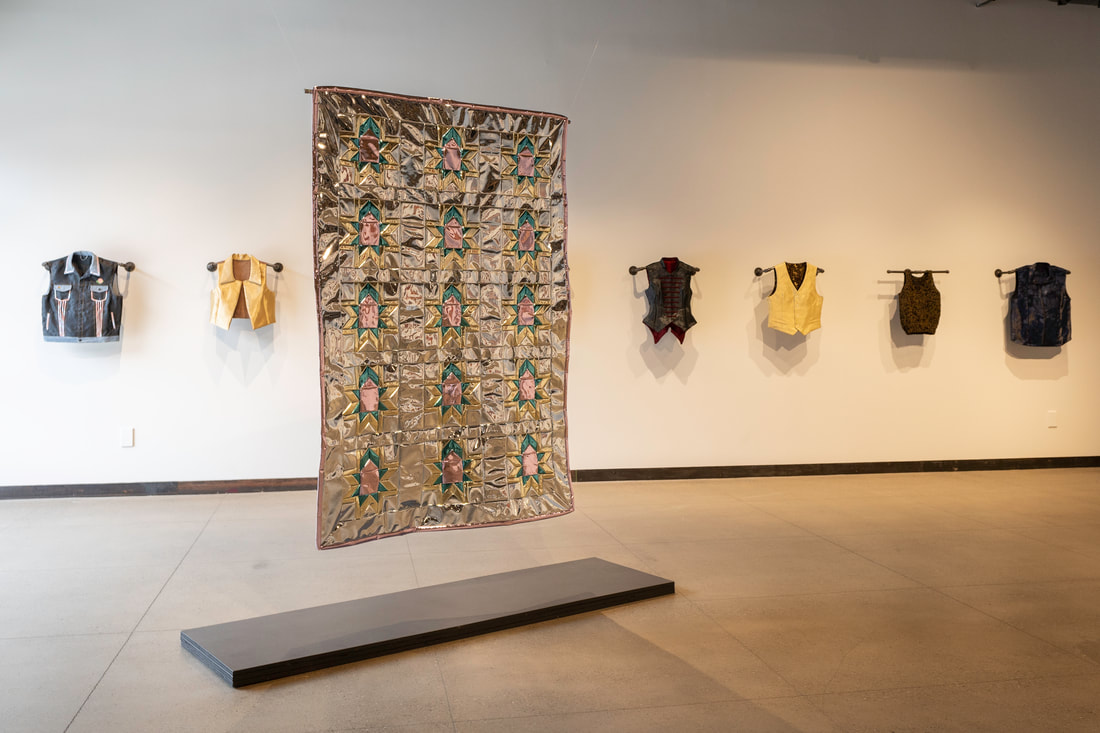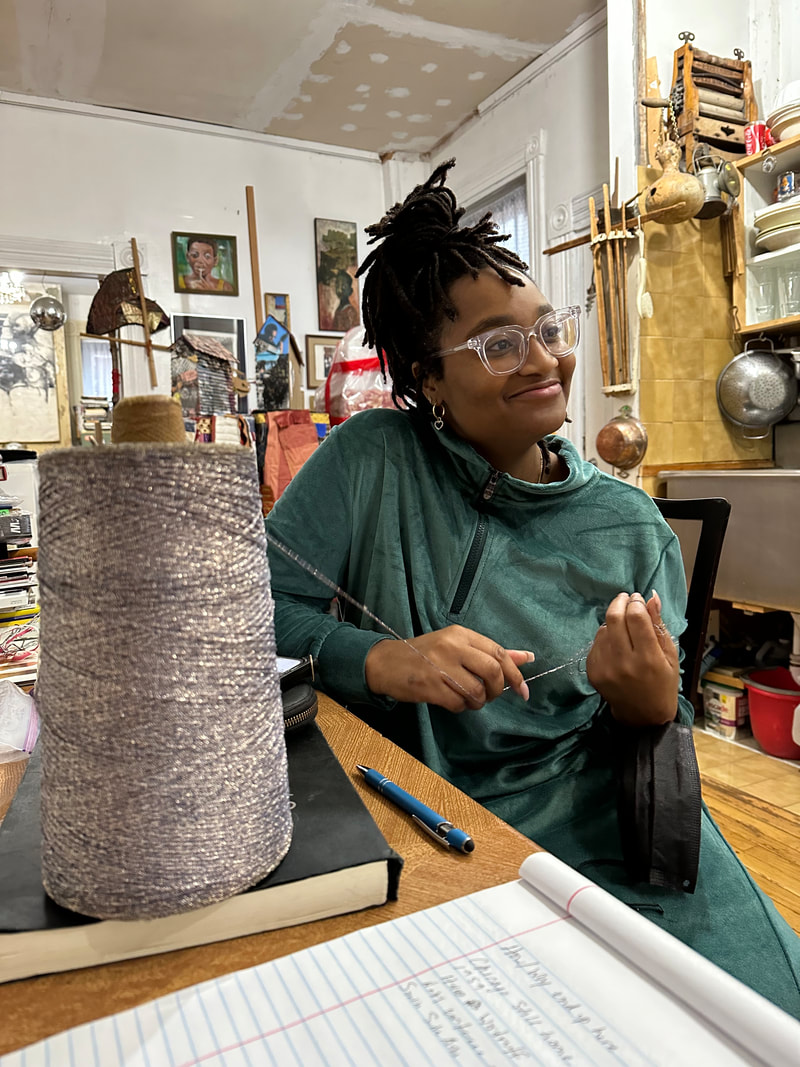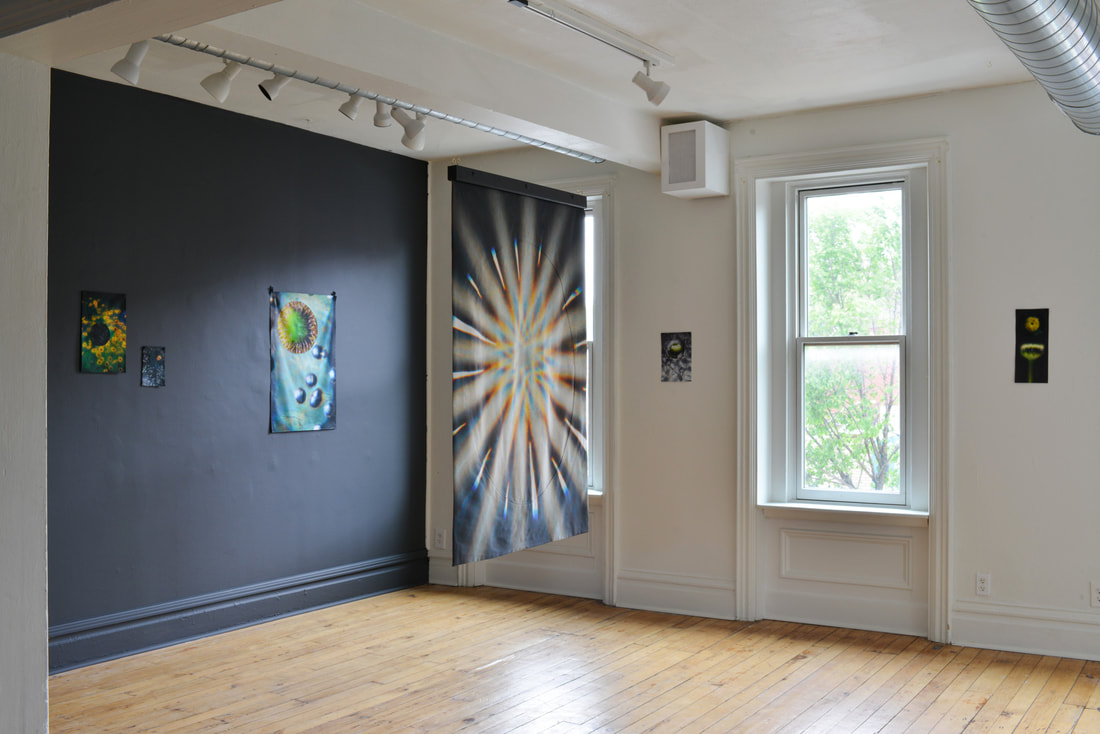Original Publish Date: 9/25/2019
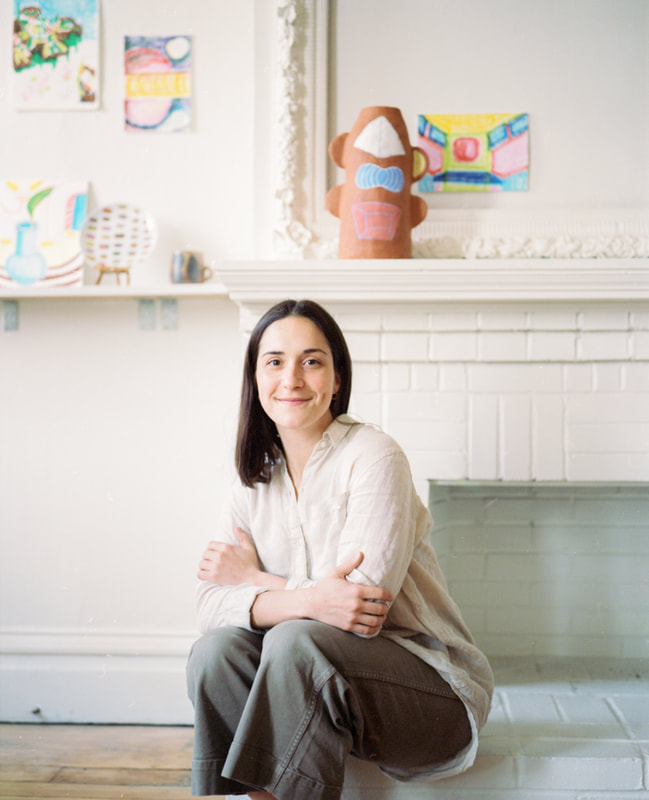
How do you describe or think about your work? In a formal/aesthetic sense and in terms of the affects or interactions it may bring to people?
Play – my work, (drawings) range from prototyping sketches to observational studies, to expressive, repetitive compositions with absurd or vibrating color – sometimes form life, other times meditative compositional studies. With ceramics my work swing from functional objects to more sculptural, but my forms gravitate toward a friendly, cartoonish quality, even the ones that are more visibly hand made – toylike.
My making, although it’s typically about the most mundane observations or nothing at all, is still very emotional for me. I create joyful objects and images, amplifying the things that bring my aesthetic of perceptual happiness (I’m like an intentional or rational optimist) by translating them through my brain and onto paper or into a vessel or object. With ceramics sometimes it is less consciously emotional, more like- “I want to make a mug!” But every mug I make I hope makes someone smile when they use it. And I find a lot of meditative joy in simply having clay in my hands. So, yeah, definitely closely related to emotion and created in the hopes that it could trigger a smile in someone.
How does your background in industrial design influence your mindset, skills, or goals in your work?
Because I have to exert creative energy and draw (much differently) at work, I feel like I gravitate towards looser or more spontaneous and meditative making with my art. That being said, my understanding of form, and the way I consider color and shape, and even the way I observe the world, is heavily influenced by my training as an industrial designer. I also think a big part of being a designer is considering how other people experience objects, images, and spaces, so I think when I make things, although most of the time they are for me, I do consider how they will be perceived by others – what emotions they trigger, what relationships they have to other things, and even what stories they could be telling. Also, studying ID taught me how to draw like an industrial designer, but studying perception and sensation in college taught me to see, which drives many of my drawings. Often thinking about how my brain is making me understand things aesthetically gets translated into my drawings. Optical illusions, how colors and shadows react, how our brains organize and fill in gaps of information – gestalt psychology – my awareness of these principles are translated from my observations and into my drawings – sometimes into my ceramics as well.
Ceramics wise – slipcasting is very ID, it’s how many commercial ceramic manufacturers produce their objects, and I like having an understanding of these principles and processes. I was into clay before I was into design, and when I realized that designers work for ceramics companies my mind kind of exploded ! I interned at a ceramic manufacturing company in Cincinnati (rookwood) and I still freelance for them from time to time, making functional housewares in 3D software for them to manufacture.
What is your studio practice like? Where/when does a piece begin and when is it finished?
My studio practice is still in search of some routine – ceramics wise I’ve jumped around so much in the past five years – I’m very excited that I just signed my lease to stay in my home for another year so I can continue to develop my home studio practice – it’s taken some time. I have worked in like six + different ceramics studios for varying periods of time – trying to find what processes are best suited for my home studio. Drawing was something I started doing pretty consistently probably like five years ago now – I started with colored pencils and a small water color set that traveled well – I would keep all of that and a little jar for water in my backpack so I was always able to draw. I liked having something portable that could travel with me – it still does. My dad bought me colored pencils, which has become a meditative hobby at the end of the day, color studies mostly. Sometimes drawing from life. Now I almost always have some combination of my sketchbook, colored pencils, and my tempera sticks with me at all times in my backpack so I can draw with downtime or when I have the urge. Drawings are really spontaneous mostly – a lot of times they start by me seeing something in the world and I’ll write a note or make an ugly sketch, take a photo or just try to remember that thing. Then later I explore that thought for a drawing or two or more – sometimes it evolves from there -other times I just scribble down ideas I have or I draw directly from life. Sometimes my drawing are more like a industrial design sketchbook or even a journal.
Ceramics often stay in sketchbook form for a long time until they become a reality – depending on what I have access to. Like the red-striped bowls – they’ve lived on paper for a while now. But when I do make, it often starts as a sketch of a form that is appealing or simply a goal of making mugs.
A lot of my work has been in my house for a long time (or in storage before then) or some with friends. Pieces start and end pretty quickly generally speaking, but they live with me a long time so they evolve as I use them or live with them. They pair with other things in my home or other things I make and take on new feelings or visual relationships. Functionality brings new life and story to objects – I often draw my vases when they have flowers in them, or my objects become a part of my still lives or the shapes that appear in my drawings repetitively. Part of the intention of this show was to recreate the way the objects and drawings work off of each other in my home in a new space, opening it up for others.
Objects are like gifts.
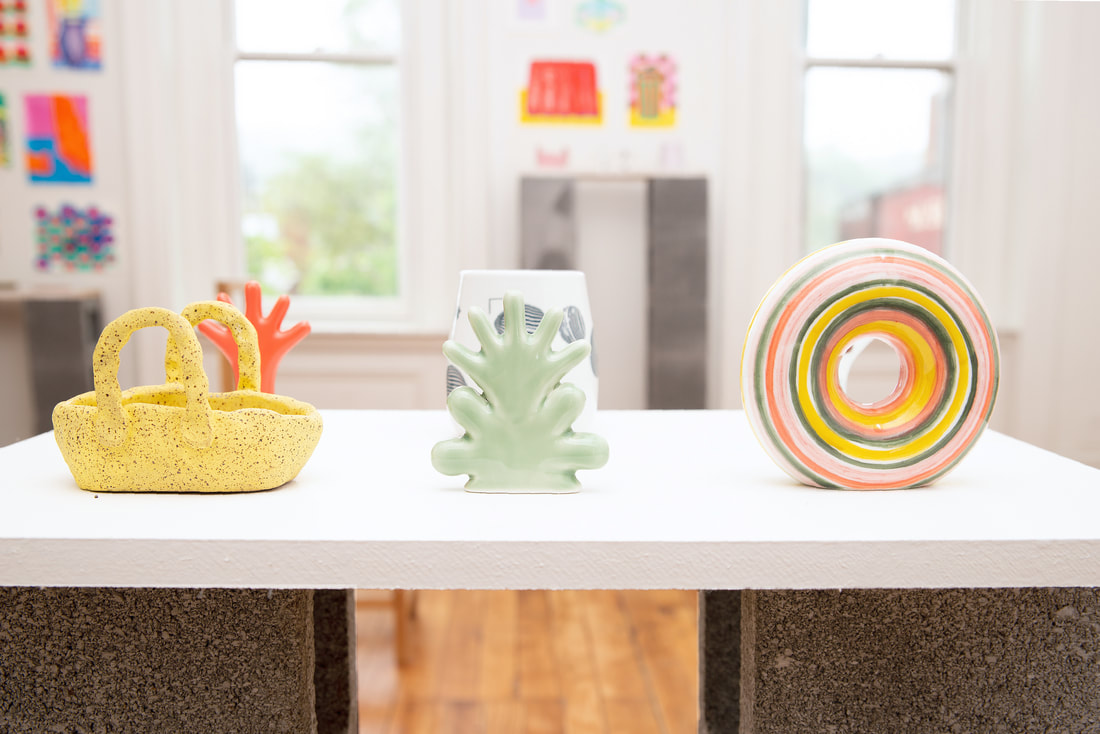
When I look at this show I see a lot of things, including transformation, and this repetitious evolution of forms. For me, some of the work is tapping into more subconscious principles and visual cues. Meanwhile other facets are much more tactile, playful and interactive-how, in your view, is art or art making a form of play?
Making and experiencing art serves different purposes for different people. For me, it is something that keeps me mentally grounded, so it is important and intentional but it is fully play. Play is such an important human behavior that we don’t have integrated into our lives as commonly any more (everyone drives for productivity, less about experimenting and playing for the sake of playing). When I’m making I often end up laughing at my work. Art making for me is playing with the perceptions in my brain and the tools in my toolbox to create little impressions of my reality. They’re all little experiments in play.
What sort of things do you notice in the world in your everyday life?
Flowers, plants, architectural details and objects found around people’s homes, interior spaces, recently I’ve been paying more attention to cars, juxtapositions, shapes against the sky, stripes, shadows, mysterious industrial objects, tiny useful objects, bright colors, clothing…
You use some ceramic techniques that are less familiar to people like 3D modeling and slipcasting. Can you talk about what that involves and also how you juggle the different ways of producing objects in this medium?
The most concrete connections between my art making and my work as a designer are 3D modeling and slipcasting. For creating and designing my forms I primarily use a software called Fusion360. Fusion360 is free for hobbyists, and it’s super intuitive and flexible. You can create very detailed and technical forms, but at the same time you can sculpt things that are cartoonish and bubbly like the little hands I make. From a digital 3D model, I then have to create a prototype, that happens in many ways, milling out a high density foam, 3D printing in resin or plastic, or even making it by hand out of plaster or clay – sometimes I just use 3D to get a sense of the forms I want to make by hand. From your prototype you make a plaster mold. In order to slipcast, you pour liquid clay (slip) into the mold. As the water is sucked out of the clay and into the plaster, an even wall thickness of solid clay forms around the interior shape of the mold. Once you have the desired thickness, you pour out the excess slip and leave your mold to dry. Eventually you can remove your casted form and clean up any part lines if desired. From here you can fire and glaze these pieces as if they were a typical clay built form. For me this process is more in my comfort zone of making because it’s essentially a manufacturing method. It is harder for me to create looser pieces when slip-casting, but it makes it possible to create repetitive forms, which is super appealing for production or play.
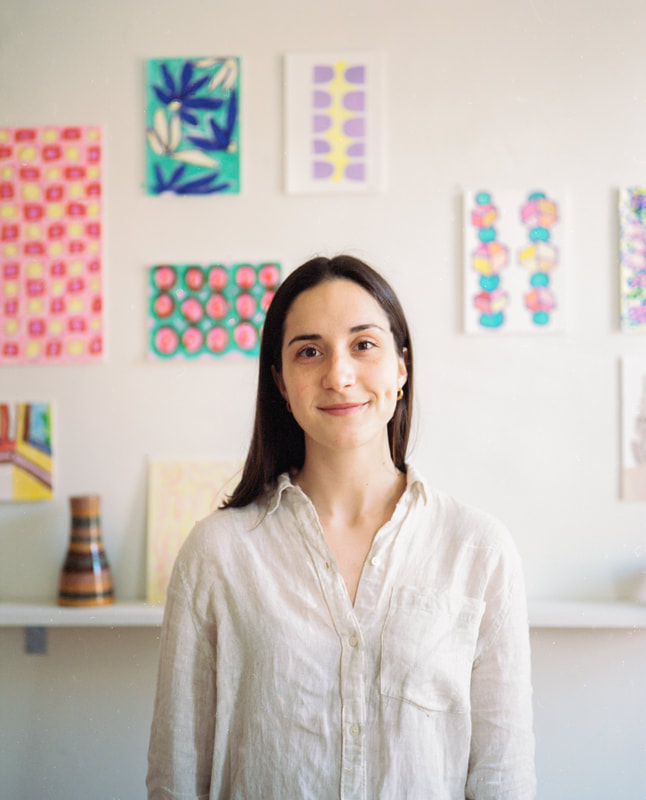
You did a really unique residency in China a few years ago. How did that experience affect you as an artist. Any important takeaways?
Yes ! that was nearly 2 years ago now, which is crazy, but that was my first time really focusing on art and art making for an extended period of time. I had a residency in Jingdezhen, China, the porcelain capital of the world, it’s basically a city built around clay (a.k.a. The wizarding world of clay). I learned a lot about the ceramic processes, and it was my first real foray into making non-functional (sculptural) work. I explored translating 2D shapes from Pennsylvania Dutch Folk Art into 3D forms, and came to China with prototypes of the forms I wanted to make. The overall experience required a lot of trust – when your work is being pushed on a wooden cart by a person you can’t understand, to be fired in a public kiln, you kind of just have to let go of any sense of control.
We collaborated with local artisans and took workshops to learn about traditional carving and blue china painting techniques. I learned a lot about how routine can shape my making. The woman who worked next to me in our shared studio was making very emotional work about protection, vulnerability, and mental health, I’d often find her close to tears (good tears, but heavy with emotion), and by contrast I was giggling and playing. This contrast was pretty powerful. Jingdezhen was also a place filled with new colors and shapes and forms to find inspiration in – I drew a lot with colored pencils and pens while I was there, and I think that was part of the foundation for my current experience with drawings.
What is your favorite piece in the show and why?
This is hard! I really like the drawing with the two vertical stacks of spheres and cube things? Something about that one is really really good to me. The shape is from a concrete post in front of a house in Sharpsburg, PA. I also really like the series of newsprint collages – I call those “Collages from a Past Life” because they are drawings from my Freshman year of school where we had to learn how to draw like industrial designers, and it was so so so stressful. Cutting them up and was a really therapeutic exercise for me. My favorite sculpture is the pink pedestal cake with the hand and the orange in front of it. The princess pink is so simple and playful; it’s a combination of handbuilt, slip-casted and thrown pieces; and it feels like growth and joy and like throwing your hands up in the air! I have too many favorites, but I also feel like the terracotta smile tile is living its best life.
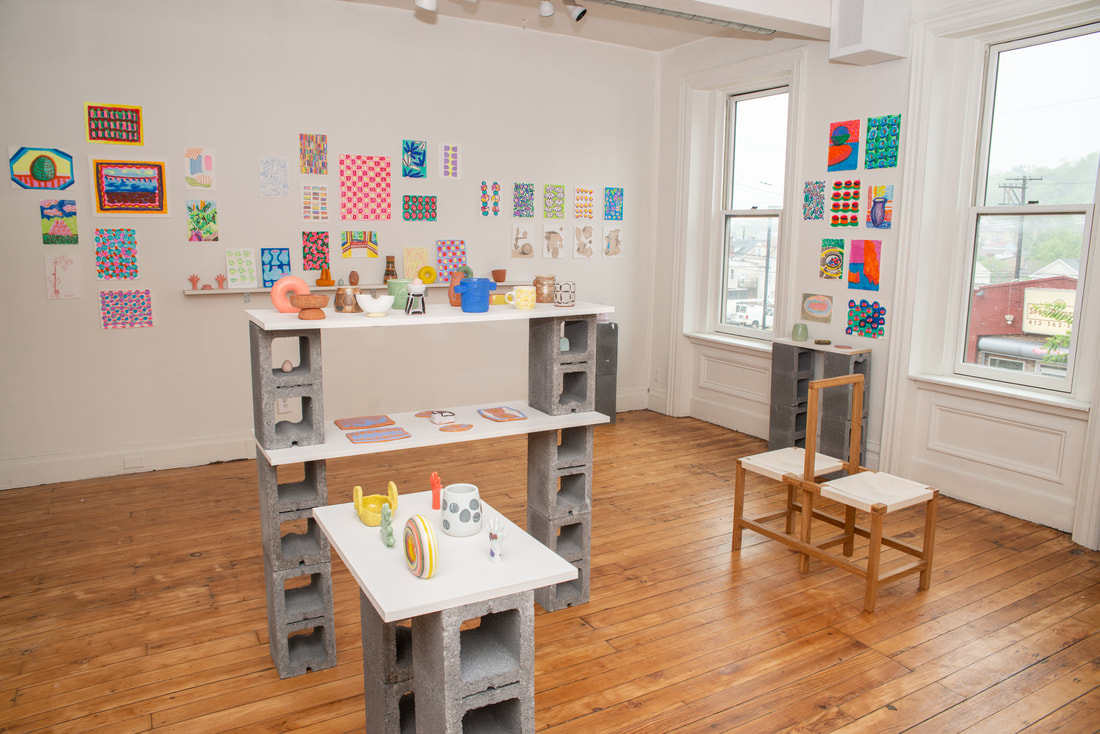
Do you have any art or life heroes? Or works of art or places that totally changed your perspective?
This is a really hard question so I’m just going to list all the people that come to my brain immediately:
- Jessica Helfand’s book Design: the Invention of Desire was an incredibly formative book for me regarding making objects and experiencing the world
- Betty Woodman’s witty, decorative, and expressive ceramics are absolutely amazing and massive
- I recently saw Lenka Clayton speak at CMU and I’m super inspired by the way she uses humor, language, and documentation to create incredible, experiential work about simple human experiences.
- I saw a Yayoi Kusama retrospective by myself at the Louisiania in Copenhagen and I spent literal hours looking at her paintngs!!!
- Agnes Martin’s meditative / minimal take on abstract expressionism. A lot of her work is about nature and observations. I’m obsessed with stripes so I’m naturally drawn to her work and it’s textural and repetitive qualities.
- Magdalena Frimkess’s ceramics, she had, I think, her first solo show in NYC recently (at age 84!) she draws and paints on ceramic forms. Her lines and surfaces have a folk quality to them that I love and her subject matter is “chosen from whatever happens that day” which I also love. People have called what she does as “daring” which I find funny and amazing because it’s just so playful and punchy yet in the ceramics world, and given the context of where she comes from, it’s seen as daring, which it is I just think that word is a kind of loaded and funny.
What projects are in your mind now, currently or in the near future?
I’ve gotta make more hands – right now I only have a few left so they have a preciousness to me that I don’t want them to have – I want to basically give them away or make them with others. I want to do a “paint your own pottery” experience with them with friends or strangers.
Right before this show I started drawing on colored paper, which sounds like a small shift, but it kind of transforms the colors in my palette when they begin on a colored field instead of stark white. Excited about this.
Also drawing a lot of plants and flowers because it’s Spring / Summer and that’s all I can think about and they make me so so happy. I’m hoping to have a Flower Show! I also would like to find my way to a wheel again, I want to make more mugs and the red striped bowls I’ve been thinking about for forever.
